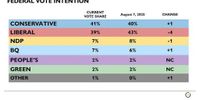With the dog days of summer winding down, a subtle but meaningful shift is emerging in Canadian federal politics. According to a new Abacus Data poll conducted between August 15 and 19, 2025, the Conservative Party has edged ahead nationally in voter intention for the first time in months. The findings, gathered from 1,915 Canadian adults, come at a moment of heightened anxiety over the rising cost of living and as the political shadow of Donald Trump begins to recede from the Canadian debate. While the survey coincided with Air Canada flight attendants launching strike action and Pierre Poilievre’s byelection win on August 18, most interviews wrapped up before these events could sway public sentiment, meaning the results capture a snapshot of opinion just before the latest tremors hit the political landscape.
What’s driving this modest but notable movement? According to Abacus Data, affordability remains the dominant issue on Canadians’ minds. A striking 60% of respondents listed the rising cost of living among their top three concerns, far outpacing other worries like the broader economy (36%), housing (35%), and healthcare (33%). Donald Trump, whose influence once loomed large in Canadian politics, was cited by just 38%—down from 44% earlier in the summer. As Abacus Data notes, this drop suggests a certain fatigue with the relentless churn of U.S. political drama, or perhaps a shift in focus as Canadians grapple with their own domestic challenges.
“After a spring and summer of stability in public opinion, we may be seeing signs of fluidity in federal politics,” observed Abacus Data CEO David Coletto. “The Carney government still enjoys a solid approval rating, Prime Minister Carney personally remains well liked, and the Liberal brand remains broadly accessible but public concern around affordability is persistent, and the Conservatives are clearly benefiting from that focus.”
The numbers tell the story. If an election were held today, 41% of decided voters would support the Conservatives, compared to 39% for the Liberals. The NDP and Bloc Québécois each hold at 7%, while the Greens and People’s Party of Canada (PPC) trail at 2% apiece. Among those most certain to vote, the race tightens to a dead heat: 41% for the Liberals and 41% for the Conservatives. It’s a reminder that, with turnout and motivation in play, the contest remains razor-thin.
Regionally, the divides are as stark as ever. The Conservatives continue to dominate in Alberta (garnering 62% support) and in Saskatchewan/Manitoba (52%), while the Liberals maintain leads in Quebec (40%) and Ontario (46%). British Columbia and Atlantic Canada remain statistical ties, with both major parties neck and neck. These patterns highlight the enduring regional polarization of Canadian politics, where the path to victory often winds through battleground provinces.
Demographically, familiar divides persist. Women and university graduates lean Liberal, while men and those with college or less education are more likely to back the Conservatives. The generational gap, once wide, has narrowed. Liberals and Conservatives are now statistically tied among all age groups except for those aged 45 to 59, where Conservatives hold a six-point advantage. The Liberals lead by eight points among women, while Conservatives enjoy an eight-point edge among men. Among those with a university degree, Liberals lead by 18, but Conservatives are ahead by 10 among college graduates and by seven among those with only a high school diploma or less.
While the cost of living crisis dominates, it’s also reshaping the issues Canadians prioritize. The Conservatives now lead on the bread-and-butter files: 39% say they are best equipped to handle the cost of living (versus 27% for the Liberals), 45% trust them most on the economy (compared to 34% for the Liberals), and 56% prefer their approach to immigration (with the Liberals trailing at 15%). The Liberals, meanwhile, retain their advantage on climate change (37% to 9%) and on Trump-related issues (56% to 21%), though fewer voters see these as top priorities now.
Approval for Prime Minister Mark Carney’s government remains relatively strong at 49%, but that figure has slipped by a point over the past two weeks, dipping below the 50% threshold for the first time since March. Disapproval has crept up to 30%. It’s not a collapse by any means, but it does signal a gradual erosion of the goodwill that carried the Liberals through the spring—a trend likely driven by mounting frustration over affordability and housing.
Carney himself remains a net positive in the eyes of Canadians, with 48% holding a favourable impression and 30% unfavourable, for a net score of +18. His strongest support comes from Quebec (+28), Ontario (+20), British Columbia (+20), Baby Boomers (+29), and higher-income Canadians. Pierre Poilievre, the Conservative leader, is holding steady with a net favourability of -2 (40% positive, 42% negative), a figure that’s remained consistent over recent months. His support is stronger among younger Canadians and men, but lower among older Canadians and women.
Donald Trump’s standing north of the border continues to languish. Just 13% of Canadians view him favourably, while a whopping 74% hold an unfavourable view—a net score of -61. While Trump’s influence on Canadian political attitudes has not vanished, his prominence has clearly diminished, allowing domestic issues to reclaim center stage.
The desire for political change remains high. Two-thirds of Canadians (66%) say it’s time for a change: 36% believe there’s a good alternative, while another 30% want change but aren’t sure there’s a viable option. Still, 34% think the Liberals under Carney deserve re-election, a figure down four points since June. The accessible voter pool for the Liberals sits at 55%, with the Conservatives close behind at 53%. The NDP remains a distant third, with 35% of Canadians saying they would consider voting for the party.
According to Abacus Data, “What’s notable this wave is that Donald Trump’s influence on Canadian political attitudes may be receding for now, allowing domestic issues to reassert dominance. That’s not good news for the governing party, which holds strength internationally but continues to face trust gaps on the economy, housing, and cost of living. And for those who believe Pierre Poilievre can’t become Prime Minister: the data doesn’t support that view. The issue set remains an asset to the Conservatives, his favourability numbers are not better than Carney’s but not bad either, and the Conservative coalition remains firm.”
As Parliament prepares to return in the fall, the political weather remains unsettled. The Carney Liberals still enjoy broad accessibility and a popular leader, but the cost of living crisis is proving a stubborn liability. For the Conservatives, the current issue environment is opening a credible pathway to power, with Poilievre’s steady—if not spectacular—numbers buoyed by ownership of the issues Canadians care about most. Whether these trends amount to a temporary blip or the beginning of a new political era will become clearer in the coming months, as both global and domestic pressures continue to test the government’s mettle.
For now, the winds may be shifting, but the forecast remains highly competitive—and, as always in Canadian politics, full of surprises.




